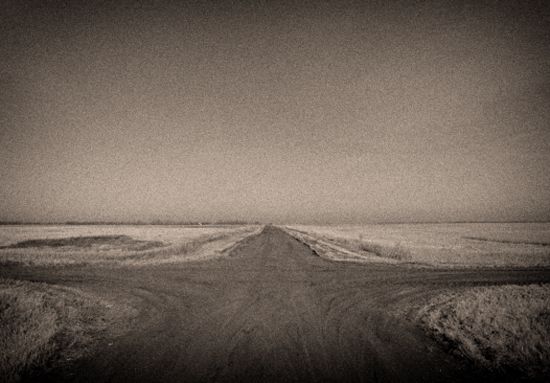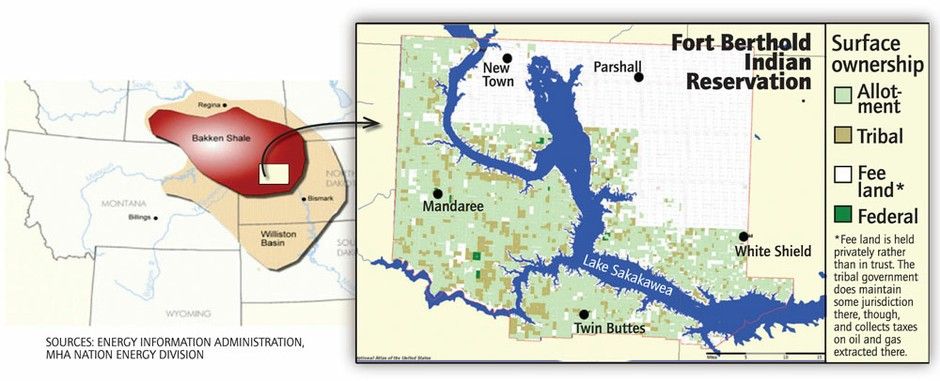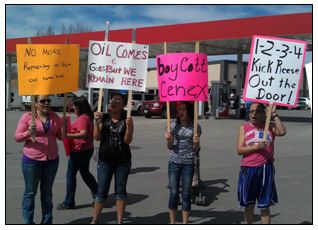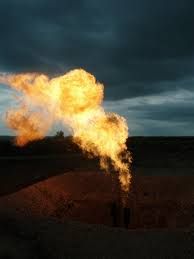 |
| Photo copyright Wings, 2013. 2014; all rights reserved. |
Author's Note: This piece first appeared as the first of a two-part series at Daily Kos on September 1, 2013, as part of the RaceGender DiscrimiNATION diary series there. Since this is Women's History Month, and since indigenous women remain invisible to the dominant culture except as cartoon characters and subjects for appropriation, it seemed an apt time to run them again. What follows is Part I; Part II will appear here tomorrow.
 This series is, among other things, about the intersectionality of race and gender in this country's culture, both historical and contemporary.
This series is, among other things, about the intersectionality of race and gender in this country's culture, both historical and contemporary. Intersectionality is simply a fact of being, of existence, for women of color. Every moment of our lives is lived at a crossroads.
Sometimes, the four roads don't lead outward, but rather, inward — toward a vortex of interrelated and competing risks, benefits, calculations, interests, slings and arrows and aggressions micro and macro and everything in between.
Today, that vortex is a place called North Dakota. It's a place that at least one writer has labeled, with frightening accuracy, a "male-dominated dystopia." For several years now, conditions have become increasingly dire for women generally. but for women of color — and particularly for indigenous women — they are downright hellish.
The further hell of it is, they've been that way for some time. And once or so a year, a few reports trickle out. They're confined mostly to blogs and Web sites of specific scope and limited circulation, and the corporate media mostly stand by and let the stories go unreported in the wider culture. Politicians and policymakers are nowhere to be found.
In other words, where the lives of indigenous women are concerned, it's business as usual.
Author's Note: At the outset, readers need to be aware of the content of this piece. much of what follows deals with stories of extreme physical, psychological, and sexual violence and human trafficking. If any of these issues presents a trigger for you, you may not wish to read further.
NORTH DAKOTA
 It's been nearly two full years since CNN first reported on North Dakota's
It's been nearly two full years since CNN first reported on North Dakota's It also encompasses land that includes the Fort Berthold Indian Reservation, home to the Mandan, Hidatsa, and Arikara Nation (sometimes known as the Three Affiliated Tribes).
Its governor is Jack Dalrymple, a Republican, of course. He loves to tout North Dakota's unemployment rate, which is the lowest in the nation. He thinks the rest of the country should follow the state's lead.
It’s estimated that the state of North Dakota, to date, has collected at least $100 million as a result of the oil boom through revenue generated from Fort Berthold alone, while the majority of Fort Berthold residents haven’t seen a dime. In the meantime, roads are crumbling as semi-trucks take over with no regards for safety. Several deaths have occurred over the past few years as a result of accidents between the semis and local Native American residents; at least 6 of the deaths involved young people under the age of 27 with the youngest being 3 years old.. . .
Crime, drug and death rates have increased all across the state as firearm sales have hit an all time high. Prostitution rings are being formed and rape rates for both men and women are on the rise with police enforcement struggling to keep up and yet North Dakota Governor Jack Dalrymple has said, "Build America back on the same blueprint that North Dakota has adopted and our country will surely be rewarded with the same great economy our state is enjoying."
He's pointedly silent on the heavy toll that it's exacting on the state's women, particularly its Indian women, to say nothing of its toll on the earth. But then, from a metaphorical standpoint, "Earth" and "Woman" are interchangeable, aren't they?
Of course, it's all of a piece with the aggressively male-dominant policies of the Republican Party generally. North Dakota passed the nation's most restrictive anti-abortion law — so restrictive that even an anti-choice federal judge felt compelled to overturn it. And the male-dominated, Republican-controlled houses of the state legislature continue to try to make state law more restrictive yet, passing resolutions seeking "fetal personhood" amendments to the state constitution, attempting to outlaw common forms of contraception, and banning abortion outright — with no exceptions for rape, incest, or to save the life of the mother.
But while North Dakota's male legislators feel perfectly comfortable regulating women's wombs, it's hands off when it comes to weapons: The state's gun laws are not merely among the least restrictive in the nation, but they actually encourage people to carry firearms. The legislature recently passed a bill permitting residents to carry guns in churches. The state house passed a bill that would have permitted people to carry guns in schools; the state senate only narrowly defeated that measure.
And, of course, this is the state that can proudly claim as its congressman none other than Kevin Cramer. That would be the Republican congressman who, at a meeting ostensibly designed to address violence against women, verbally bullied one of the two Native women attendees, informed her that he wanted to "wring the Tribal Council’s neck and slam them against the wall," and proceeded to try to put his arm around the other Indian woman present (who was already in tears) without her consent.
This is what passes for political representation in North Dakota.
NEO-NAZIS, TOO?
North Dakota, and specifically the Bakken area, is most recently in the news for an attempt by neo-Nazi Paul Craig Cobb to take over the village of Leith, some distance southeast of Williston, and turn it into some sort of Aryan Eden.
Townspeople, including Mayor Ryan Schock, are saying they'll fight back any attempt to take over the town — to the point of dissolving the town government and turning it over to the county, if necessary.
Perhaps more interesting, to my mind, is who and what Cobb sought to bring to the area, and how:
In a posting on the Internet, Cobb invites like-minded nationalists to join him in Leith to fly Nazi flags and other racialist banners and bring more “hard core” white nationalists.
He said anyone moving to Leith should become a resident and vote in the local elections.
In the posting, threaded through the white supremacist Vanguard News website, he writes: “A few well know (sic) WN (White Nationalists) know of this plan; fewer still know the exact place. Suffice to say, you could also make it into the Bakken area to go for a job there too. I want people to move now and quietly get going here without letting the cat out of the bag.”
Why do I find this so interesting?
Because the Bakken is already well known as a hellhole of abuse and violence against Indians, particularly Indian women. Bringing such a population to the area to work and live would plunge it to even greater depths. In addition to remarkably low land prices in an area with a severe housing shortage, it has an added attraction: the presence of a ready supply of targets for their racism.
CRIME IN THE BAKKEN
Two years ago, sporadic reporting noted the dramatic increase in crime in the Bakken:
Within the last few months, a Watford City pharmacy was robbed of $16,000 in narcotics, four people were stabbed at a local strip club in Williston, a semi truck crashed into an RV full of people sleeping and the first prostitution ring in decades was busted.
Last year, the number of criminal incidents reported to the Williston Police Department nearly tripled to 16,495. But that's only a fraction of the lawlessness the police have seen this year.
"The numbers we are seeing for this year will blow these out of the water," said Lieutenant David Belisle.
In a single month this summer, the department received 1,000 calls -- compared to the 4,000 calls it received in the three-year period between 2007 and 2009. This year, 9-1-1 calls to the department have already more than tripled last year's call volume, he said.
Prescription drug abuse, particularly of Oxycontin, is rampant. So are the thefts that typically accompany such an epidemic. DUIs and incidents of violence have similarly skyrocketed. Prostitution — in this case, more properly called human trafficking — virtually nonexistent until a couple of years ago, is now everywhere.
So is rape.
With a rate of over one hundred rapes per 100,000 residents, Williston now has a rape rate that is nearly four times the national average. A woman in Williston, North Dakota is four times more likely to report being forcibly raped than a woman living in Los Angeles and over seven times more likely than a woman residing in New York City. Williston’s per capita rape rate is higher than that of all but one of the 214 US cities with a population of over 100,000 residents, including Detroit, Chicago and New Orleans, cities usually regarded as among the nation’s most dangerous places.
IN THE MAN CAMPS, NATIVE WOMEN ARE TARGETS
They call them "man camps." It sounds like a cross between something out of Calvin and Hobbes ("no
In reality, they're something much more sinister.
Earlier this year, a reporter for The Atlantic, Sierra Crane-Murdoch, covered the man camps in sickening detail. She recounted a slowly-growing awareness among area law enforcement that Native women, whose assaults are historically underprosecuted in the first place, were increasingly becoming explicit targets:
Fort Berthold, like many reservations, has a long history of crimes slipping through jurisdictional cracks. Sadie Young Bird, director of the Fort Berthold Coalition Against Violence, told me that before 2010, when the Tribal Law and Order Act passed Congress, very few sexual assault cases reported on the reservation were prosecuted. The Act provided greater resources for tribal law enforcement agencies, in part by encouraging U.S. attorneys to hire special assistants to boost prosecution rates. In 2011, Assistant U.S. Attorney Rick Volk was appointed to work specifically with Fort Berthold. Between 2009 and 2011, federal case filings on North Dakota reservations rose 70 percent.
When I asked Tim Purdon, North Dakota's U.S. [A]ttorney, if the numbers had anything to do with a rise in crime, he first insisted they did not. He believed there was a growing sense among Native American victims that the crimes they reported would be prosecuted, and this encouraged more women to come forward.
But beginning last summer, Purdon noticed a peculiar pattern emerging from Fort Berthold. Many of his filings—a surprising number of them—involved non-Indian perpetrators. "We had five or six in a month," he told me. "Why was this? We realized it's non-enrolled folks moving to the oil patch."As Crane-Murdoch points out, the Fort Berthold Reservation's effective population "doubled" in a very short period of time, without accompanying infrastructure to support such an increase. But more to the point, the new "residents" — now more than 4,000 of them — are neither tribal members nor even Indian. And that's the dirty little secret of law enforcement in the Bakken:
A year earlier, I had stood in this camp with a mechanic from Washington, a friendly, jovial man, who marveled at the seeming lack of rules here. "Basically," he said, "you can do anything short of killing somebody."
When I share this quote with tribal officers, none ever seems surprised. What the mechanic said was not entirely true—cases that fall outside tribal and federal jurisdiction belong to the state. But several officers insinuated that crimes committed on Fort Berthold are often a low priority for deputies and sheriffs, who are already overworked by the boom outside reservation borders.And the non-Indians know it. Not only do they know it, but they exploit it. Proudly.
It was as though, tribal officers said, their lack of jurisdiction had encouraged a culture of lawlessness. Every officer could recount being told by a non-Indian, "You can't do anything to me." Once, when Young Bird and [tribal investigator Angela] Cummings went into a man camp to check on a domestic violence victim, the manager of the camp said, "Women aren't allowed here," and shut the door. "Perpetrators think they can't be touched," Young Bird told me. "They're invincible."The same reporter interviewed Fort Berthold tribal police officer Nathan Sanchez at some length. The stories Officer Sanchez tells are bloodcurdling:
One morning a few weeks earlier, Sanchez had just come on duty when he stopped a man for reckless driving. "Come to find out, this guy is one of those sex offenders that kills his victims after. It's like, what the freak is going on here? I don't even have my coffee yet."Serial killers.
Most of the violence, of course, is much more mundane. For too many indigenous women, it's long been a way of life. But the situation at Fort Berthold takes it to a whole other level.
To understand its significance, you need to understand the context in which it occurs: a context in which American Indian women are, and have been, very specific targets of physical and sexual violence, in ways that other women are not.
VIOLENCE AGAINST NATIVE WOMEN, BY THE NUMBERS
I've written about this topic more times than I can count. Truth be told, I'm tired of it. Bit as long as Native women remain targets, it has to be done.
I am not, however, going to reinvent the wheel. I've previously done a thorough dissection of the statistics, and I'm going to reproduce it here. Sadly, not much has changed in the intervening years — physical violence against their people's tribal council.
A Legacy of Conquest
In nearly 500 years of contact, rape has been part of a deliberate strategy of war, conquest, and annihilation of Native peoples. It was not uncommon for European settlers to assault Indian women on an individual (or group) basis, but more than that, rape was one of many weapons in the U.S. government's arsenal as it executed its policies of Manifest Destiny and Indian removal.
Of course, the written record is sparse with regard to rape of Native women. To the victors who kept the records, we were not important –- we weren't even fully human. But our memories are long, and our oral traditions strong, and the stories are handed down from generation to generation.
. . .
This behavior was not unusual. To a patriarchal culture that regarded Indians as something less than human, the ability to rape Native women with impunity was seen as nothing more than their due –- the spoils of conquest and colonialism. And they violated, despoiled, and stole our grandmothers' bodies and souls in the same way that they violated, despoiled, and stole the body and soul of Akii, our Mother Earth.
Amplifying Violence
There's a significant and deadly difference in rape statistics as they relate to Native women:
Among rape victims in the general population, 74% report being physically battered in additional ways during the commission of the rape. For Native women, that number jumps to 90%.
Among the general population, 30% of rape victims report sustaining other physical injuries, in addition to the rape itself. Among Native women, that number is 50%.
Roughly 11% of rape victims as a whole report that their rapist used a weapon. For Native women, that number more than triples, to 34%.
Taken in historical context, and coupled with the fact that 86% of all rapes of Native women are committed by non-Indians, it's hard to escape the conclusion that something even more insidious is at work here.
Eluding Jurisdiction
Most rape survivors are attacked by a member of their own racial or ethnic group: In other words, white women tend to be sexually assaulted by white men, African American women by African American men, etc. The one group for whom this rule does not hold is Native American women. As noted above, more than 86 percent of Native rape survivors are attacked by non-Indians, (more than 70 percent of whom are white).
Why does this matter?
It matters because, until [2010], the vast majority of Native women rape survivors had little or no legal recourse: Even where the victim is a tribal member, tribal authorities have had no jurisdiction over non-Native defendants. With limited exceptions, only federal authorities have had jurisdiction to arrest and prosecute non-Indians who commit crimes on tribal lands -- and historically, cases involving violence against Native women have received little to no attention. As I've noted elsewhere, "[f]ederal authorities routinely decline to prosecute more than 50 percent of all violent crimes committed in Indian Country; the rate of declination is much higher for sexual assault cases."And even the passage of the Tribal Law and Order Act is insufficient to control the epidemic of violence. This year's renewal of the Violence Against Women Act [VAWA] will help, but as the preceding passage shows, in places like Fort Berthold, it won't even put a visible dent in the problem. The scope is too great; the resources are too few. Even fewer are those resources known as political interest, political will, and political clout. Dalrymple and his cronies in Congress, the state legislature, and the energy companies have none of the first two; indigenous women have none of the third.
And increasingly, they're losing the most fundamental of resources that would help them to avoid such situations. Resources like, oh, say, a home.
FORCED HOMELESSNESS
 We've long known that one of the biggest drivers of prostitution and human trafficking is homelessness.
We've long known that one of the biggest drivers of prostitution and human trafficking is homelessness. It's also a common outgrowth of domestic violence.
In the Bakken, that seems to be a feature, not a bug. It's increasingly being used as a bludgeon on Native women and families, forcing them out to allow landlords to rent the properties to well-paid oilfield workers . . . and creating a whole new underclass of targets for violence in the process.
Forced evictions, of local residents from their mobile homes in the New Town area, to provide housing for predominately out-of-state oil workers has reached a new low. On Monday, April 16th, [2012,] four Native American residents of the Prairie Winds Mobile Home Park, including a 9-year old child, were forced to leave their home when [the] landlord, Leroy Olsen, removed Heather Youngbird and Crystal Deegan’s front door. Olsen then cut the electricity and turned off the propane to the home, and told them they had to leave their home immediately.
Why? To make room for white oil company employees, from executives in company offices to roughnecks out in the fields. It's spawned an entire satellite industry in "housing acquisition," via which white-owned companies seeking to profit off the oil boom buy up area properties on the cheap, evict Native tenants and their families, and leverage sales and rentals into exorbitant profits.
[United Prairie Cooperative CEO and general manager and Future Housing LLC agent John] Reese said in an interview last month the housing shortage in the area makes it difficult for him to find employees. Available land to develop housing is also difficult to find, he said. "Right now, anything that’s available that has water and sewer on it is very attractive to anybody that’s trying to continue to grow their business." On Saturday, Reese said he was aware of the protest but he was out of town planting potatoes. Many of the signs and chants targeted Reese directly. "I'm just fine with taking the rock beating," Reese said. Indeed[,] John Reese has proved that he’s fine with displacing people because this isn’t the first time he’s done it. In 2010 he displaced people from the Four Corners trailer court behind the old Charbee’s and the second time he displaced people from the old movie theater apartments on main street. Tribal members are still paying back loans they had to take from the tribe to help pay for the moving expenses.What a shining example of everything wrong with this picture. He's proud of what he does, which is throwing Native women and children into the street. Once again, violent invaders are stealing fundamental resources from the land's historical inhabitants, and once again, with brutal, even deadly, results.
Add to this travesty the fact that North Dakota has few shelter and other services for survivors of domestic violence and sexual abuse, and it's a recipe for wholesale destruction.
"HEADING TOWARD MODERN-DAY GENOCIDE"
 Some tribal members express fears about what a future that includes the Bakken holds for their people:
Some tribal members express fears about what a future that includes the Bakken holds for their people:"This oil boom has divided the Mandan, Hidatsa and Arikara people and pitted them against each other in a negative way," says tribal member Kandi Mossett. "It’s really hard to see the damaging and negative effects occurring at Fort Berthold and throughout North Dakota as a result of corruption and greed. The reality is that people in positions of power at both the Tribal and State level are lining their own pockets, while the Mandan, Hidatsa & Arikara people suffer and in some cases die as a result of this terrible oil boom. I want people to know the reality we are facing here and to realize that at this rate we are heading toward modern-day genocide of the people, while the BIA and others stand idly by and let it happen."
As I've noted repeatedly elsewhere:
Genocide need not depend upon heedless and bloody slaughter.
Stealing the children is enough to do the job.
So is stealing the lives of the women who would bear the children.
So is stealing the very earth that supports and sustains a culture and its people.
And once again, indigenous women, the earth mothers, are stand-ins for Mother Earth . . . and targets in their own right.
Copyright Ajijaakwe, 2013, 2014; all rights reserved.

No comments :
Post a Comment